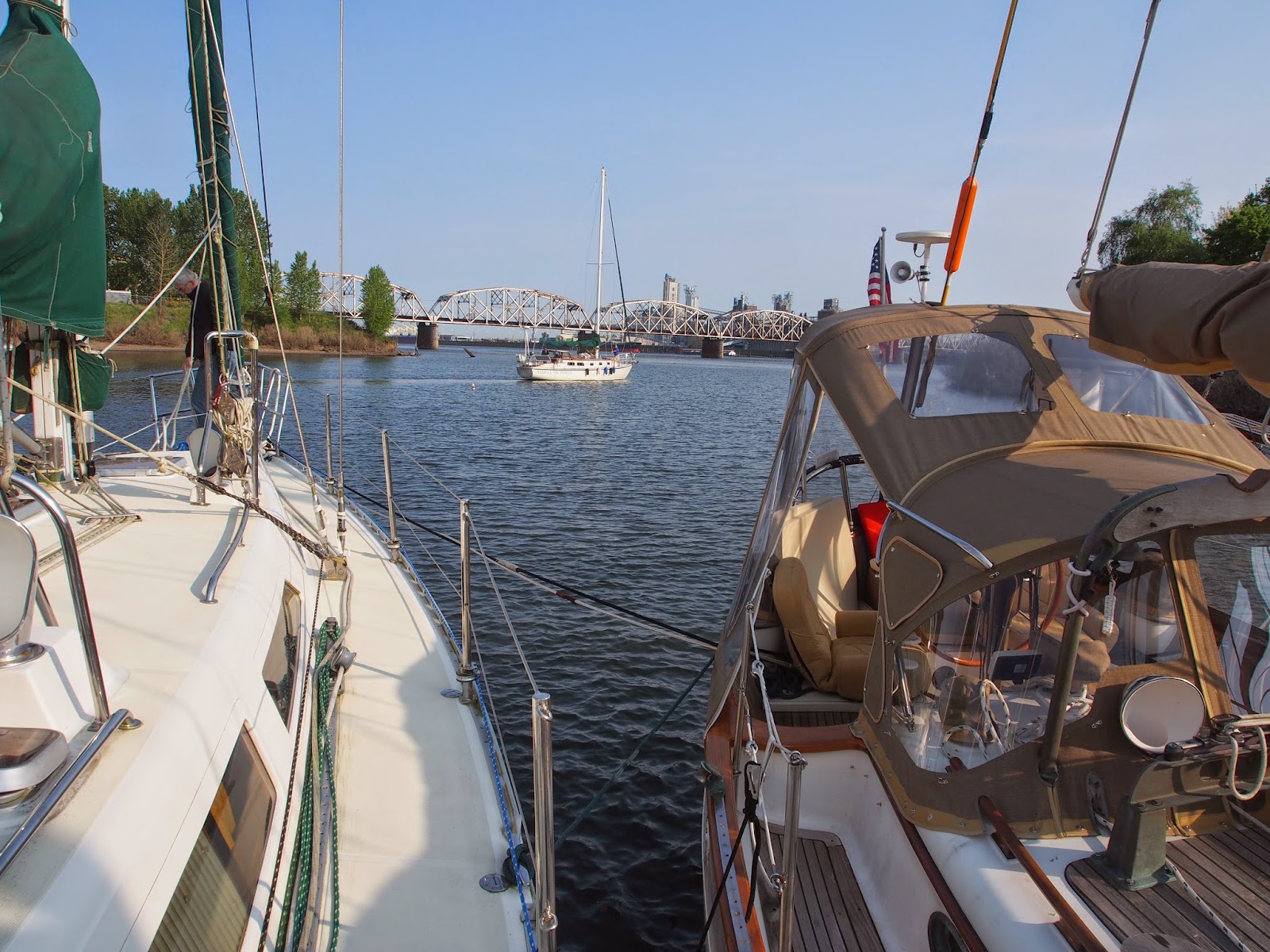The quiz took me about six hours to complete, I had finished about two days before we took off for the cruise. Our yacht club's commodore Craig Johnston designed the quiz such that it told the story of your spouse, sister, your brother in law-Larry, and yourself aboard a charter boat the S/V Plastique. As the story progressed through the series of questions, your clumsy, haphazard brother-in-law pretty much destroys all the usable navigation technology aboard the charter boat.
April 17, 2015
I had gotten up very early (4:00am) in the morning and moved the all the provisions on board, including our new Bottom-Siders cockpit cushions, and our stay sail jib. Afterward went off to work for the day. Charing and I arrived at the boat about 4:30pm after work and began getting ready to leave. We untied the boat about 5:20pm and motored at 6 knots with a 2 knot current to arrive at Grandma's Cove about 6:10pm. Upon arriving we called out to everyone on our designated channel 69, but we got no answer. When we rounded the corner we realized why, we the first ones to arrive. Since we weren't certain where to drop anchor we tied up to the docks at Schooner Creek Boat-works until another boat arrived. The winds picked up through the next hour until they were about 18 knots inside the cove. About 7:00pm our good friends Ray and Alicia arrived on S/V Rowena. They docked near the north-west corner of the cove and beckoned over to anchor the opposite way so they wouldn't be blown into the shore. Ray pointed to the far western side of the cove and said to drop anchor there. We did, but soon realized we'd never get enough rode out to raft unto Rowena. We recovered the anchor, but not before having our first grounding on the new bottom. I backed off the grounding and anchored closer to Rowena under Alicia's instructions this time. Within no time we were anchored and rafted up to Rowena. Throughout what could have been a stressful adventure, Charing's attitude was outstanding, encouraging me with the phrase, well we have to learn how to do this anyway might as well do it again.
Ray and Alicia came aboard for dinner and drinks. We had a great time talking through the night.
April 18, 2015
We woke up late about 9:00am after a restful sleep. Charing and I both were looking forward to making coffee with freshly ground 100% Kona coffee. Those desires were not to be, as I'd forgot to check our propane tank; it was empty. Thankfully Alicia came to our rescue cooking the eggs and Portuguese sausage we brought for breakfast. She made some great coffee too. Alicia makes the world's best potatoes in the USA (Ireland is hands down the best.) As we finished breakfast we peered over Rowena's dodger to see S/V Sequoia on the far side of the Vancouver Railroad bridge. Several trains past, over the bridge until the bridge swung to the side allowing them to come into the bay. Craig and Barbara tied up next to us on our starboard side. Gary Weber came next, tying up to Rowena. JuliaMax made her way into the bay shortly after, rafting up to Sequoia. Terry and Michelle on Conch came next rafting up to JuliaMax. Paul on Openwater came in as well rafting up to Gary. Maria Victoria was the last to come into the raft joining S/V Conch.
 |
| SIYC Navigation Cruise Raft Up the very stern of CarolMarie is seen (courtesy Gabrielle Drowding) |
By about 3:30pm Gabrielle, Michael, David, and Kim Winkler came in by car and ported over thanks to Ray's dinghy. Craig held the answer session in the cockpit of his boat.
 |
| Terry and Charing going through the answers from the quiz. |
 |
| Everyone checking their answers |
Following the quiz a pot luck dinner was hosted aboard CarolMarie due to her being the middle of all the boats in the raft.
 |
| People having dinner aboard CarolMaire (courtesy Barbara Johnston) |
 |
| Buffet on the deck CarolMaire (courtesy Barbara Johnston) |
 |
| Sequoia and CarolMaire rafted up (courtesy Barbara Johnston) |
 |
| Gary Weber having dinner aboard CarolMaire (courtesy Barbara Johnston) |
 |
| Ray and Michael discussing rigging on Rowena and the stern of CarolMaire (courtesy Alicia Watkins) |
Gary, Paul, Ray, and Alicia joined us for a nightcap on CarolMarie. We then turned in for the night.
4/19/2015
After a group breakfast the flotilla broke up, and everyone went on their way home. Charing and I stopped at the pump out station deciding to clean out the holding tank with various types of treatments to ensure a clean smelling boat for the next time out. We docked about 4:00pm in our slip, spending a couple of hours cleaning the hull, deck and putting everything away.
The 2015 SIYC Navigation Cruise was over - it was a blast, despite the antics of fictional Larry; the brother-in-law that ruined all the electronics on the boat. Thanks to Craig and Barbara Johnston for hosting, and sharing pictures.